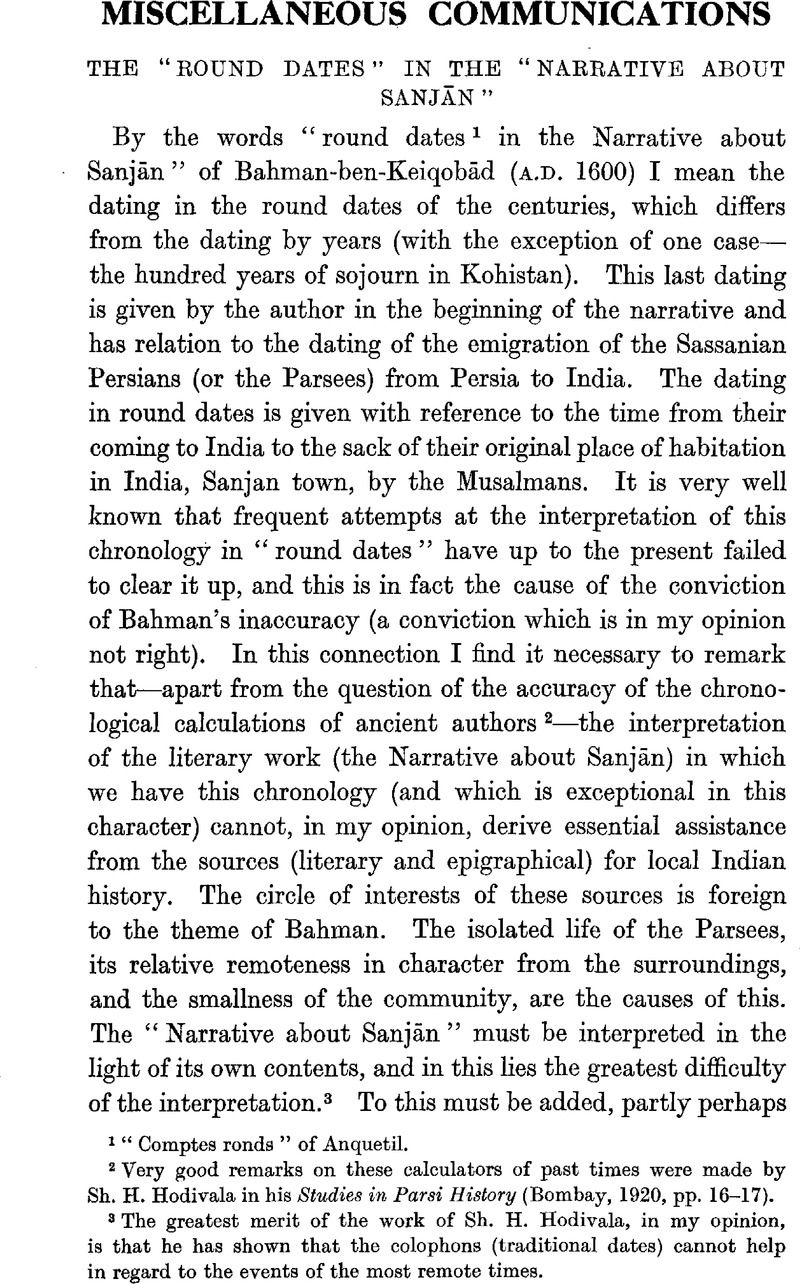No CrossRef data available.
Article contents
The “Round Dates” in the “Narrative about Sanjān”
Published online by Cambridge University Press: 15 March 2011
Abstract

- Type
- Miscellaneous Communications
- Information
- Copyright
- Copyright © The Royal Asiatic Society 1935
References
page 509 note 1 “Comptes ronds” of Anquetil.
page 509 note 2 Very good remarks on these calculators of past times were made by Hodivala, Sh. H. in his Studies in Parsi History (Bombay, 1920, pp. 16–17)Google Scholar.
page 509 note 3 The greatest merit of the work of Sh. H. Hodivala, in my opinion, is that he has shown that the colophons (traditional dates) cannot help in regard to the events of the most remote times.
page 510 note 1 The Narrative about Sanjān has been twice translated into English—by Eastwick, and recently by Hodivala (op. cit., pp. 94–118). I find it necessary to say here that the reading of the word ![]() conjecturally as the name of the local dynasty Shilahra (pp. 75–6) is impossible from the point of view of versification. The first and the second syllables must be long and short. This word can be translated by the usual word— Mahārājās. The conjecture was regrettably introduced into the translation, p. 102. On the other hand the author's identification of Ibn Batūta's Moghistān with Bahman's “Hurmuz” is indisputably important and, in my opinion, right (p. 100, n. 19).
conjecturally as the name of the local dynasty Shilahra (pp. 75–6) is impossible from the point of view of versification. The first and the second syllables must be long and short. This word can be translated by the usual word— Mahārājās. The conjecture was regrettably introduced into the translation, p. 102. On the other hand the author's identification of Ibn Batūta's Moghistān with Bahman's “Hurmuz” is indisputably important and, in my opinion, right (p. 100, n. 19).
page 510 note 2 See Modi, J. J., A few events in the early history of the Parsis and their dates (1905, p. 9)Google Scholar, and my “Emigration of the Parsis to India and the Musalman world in the middle of the Vlllth century” (Journal of the Cama Oriental Institute, Bombay, No. 1, 1922, pp. 35–6)Google Scholar.
page 510 note 3 Cf. ibid., p. 13—“Of the six MSS. of the Kissah—some of them very good and old—which I have seen, there is not one in which it does not occur”; and Modi, pp. 27–8. The following verse, ending this portion of the narrative, can characterize the event which followed the term of 700 years: “and there in some years was struck a blow which destroyed the former happy life (![]() and
and ![]() ).
).
page 511 note 1 Modi, pp. 32–5.
2 Modi, p. 41.
page 511 note 3 Hodivala, pp. 63–4: “Bahman … himself had no starting point.” The translations of Eastwick and Modi “after 500 years” and “at the end of 500 years”, are more closely answerable to the text— ![]() —than “some time after” in the translation of Hodivala.
—than “some time after” in the translation of Hodivala.
page 512 note 1 ![]()
page 512 note 2 I understand this passage to mean: approximately after 300 years the dispersion from Sanjān was finished.
page 513 note 1 Probably for this reason his work is not named “Narrative about the Zoroastrians in India” (![]() ), as Shāpūrji Mānukjī in the eighteenth century named his work. (In his account of the earlier period he follows Bahman and connects the round date 700 with the Musalman conquest. See Journal of the Cama Oriental Institute, No. 17, 1930, pp. 22 and 59Google Scholar.) The disposition of the dates 300 to 200 agrees with that given by Bahman (cf. pp. 20, 22, 57, and 59). It is necessary to note the following: Hodivala in his translation, p. 115, note 52, supposes that the fire Irānshāh was transported to Nawsārī two to three months after the Jashni-Sada; but in the text we find only that after this period of time Chāngā Āsā formed the intention and laid the proposal before the community—not that the fire was transported after this period of time (Hodivala, pp. 115–16).
), as Shāpūrji Mānukjī in the eighteenth century named his work. (In his account of the earlier period he follows Bahman and connects the round date 700 with the Musalman conquest. See Journal of the Cama Oriental Institute, No. 17, 1930, pp. 22 and 59Google Scholar.) The disposition of the dates 300 to 200 agrees with that given by Bahman (cf. pp. 20, 22, 57, and 59). It is necessary to note the following: Hodivala in his translation, p. 115, note 52, supposes that the fire Irānshāh was transported to Nawsārī two to three months after the Jashni-Sada; but in the text we find only that after this period of time Chāngā Āsā formed the intention and laid the proposal before the community—not that the fire was transported after this period of time (Hodivala, pp. 115–16).


